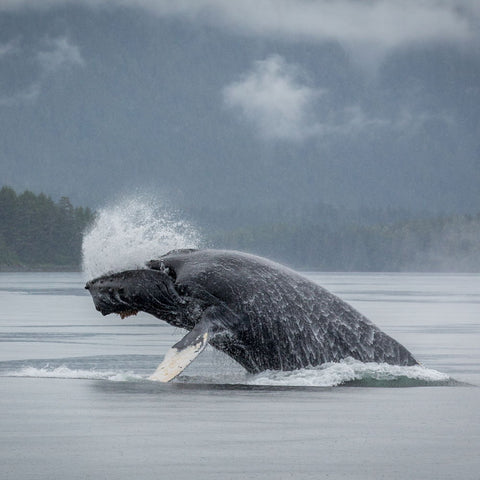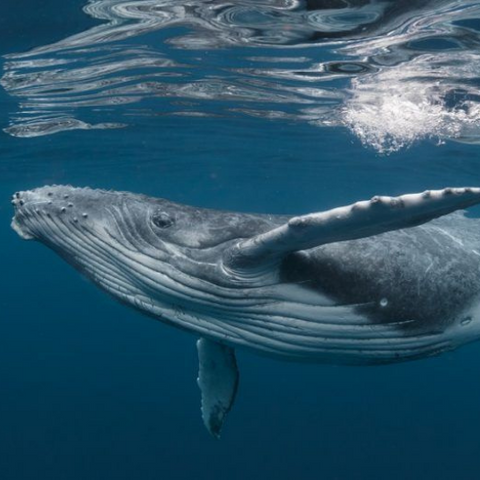
Ocean Alliance, Inc.
See our GiftsOverview
Ocean Alliance is a 501(c)3 charitable organization founded with the purpose of protecting whales and their ocean environment. We were founded in 1971 by Dr. Roger Payne, making us one of the oldest charities in the world dedicated to the protection of whales. Dr. Payne is widely recognized as the father of modern whale biology, and his discovery that humpback whales sing songs was a hugely important catalyst for the ultimately successful Save the Whale movement to ban commercial whaling.
Mission
Ocean Alliance's mission is to protect whales and their ocean environment through research and education. Owing to our long history in this field, and through some significant discoveries and programs‚ the discovery of humpback whale song; the development of photo-ID as a research technique (it remains to this day perhaps the most important single research technique in whale science); the Voyage of the Odyssey; and most recently, SnotBot. we are widely respected across an extensive network of scientists, conservationists, educators and policy makers all across the world.
History
The crucial part of our ethos is that we always try to spend our time and energy where we believe we can have the greatest impact on preserving whales and their environment.
In the 1970s, as many species of whale were pushed to the very brink of extinction, Ocean Alliance started with the idea that more could be learned from a live whale than a dead one, and at first, our efforts were spent on learning more about whales at a time when almost nothing was known about them.
 
In the 1980s, as commercial whaling drew to a close, Ocean Alliance focused on educating the world about whales: through interviews and stories with the media, a series of educational school programs, and a public outreach drive partnering with groups such as the Discovery Channel and Pacific Life.
In the 1990s, with the idea that people would only protect what they loved, Ocean Alliance set about trying to make people fall in love with whales by showing them their beauty, and became involved in the production of over 40 documentaries, including In the Company of Whales and the IMAX film Whales. Ocean Alliance, and its research vessel, Odyssey, were involved in the production of many of the early documentaries on whales.
In the late 1990s, Ocean Alliance became increasingly worried about pollution in our oceans, and how little was being done to study this pollution and bring it to light. With this in mind, we started planning a major expedition, and in 2000 the Voyage of the Odyssey was launched. This was the first-ever global study of pollution using a single species, the sperm whale, as an indicator. The five-year expedition shed light on the horrifying levels of pollution in all of the waters of the world.
In 2010 the Deepwater Horizon oil rig exploded, releasing around 5 million barrels of oil into the Gulf of Mexico. In response, Ocean Alliance spent five years in the Gulf of Mexico, studying the impacts of the oil spill on marine life.
In 2013, CEO Dr. Iain Kerr recognized an emerging technology that could hold the key to the future of whale research and conservation: drones. With this, Ocean Alliance's research activities shifted, and in October of 2015 the first SnotBot Expedition was launched to Patagonia, Argentina. The Drones for Whale Research (DFWR) program (with the flagship SnotBot program at its core) aims to facilitate and accelerate the use of drones in marine mammal science. We believe that drones have immense potential in cetacean science and conservation as cost-effective, scalable, adaptable, and non-invasive tools, which have significant implications for management strategies and policies worldwide. Partly through the efforts of Ocean Alliance and its protocols, drones are rapidly becoming key components of whale research programs all across the planet.
Program
Our oceans are changing. Whales and dolphins today face more threats than ever before, and these threats are diversifying and intensifying. Whilst some species have recovered from commercial whaling, others are critically endangered: The vaquita looks set to soon go extinct, with others not far behind. We are failing. It is simple: to protect these animals and secure their survival in a changing world, we need to understand these threats and how they are impacting the animals.
And for this we need two things: more data and better data.
The challenge we face is that collecting very robust data on marine mammals is expensive work. This greatly reduces the number of people/groups that can carry out this work, and consequently the amount of data that can be collected. Marine mammal science needs a revolution. At Ocean Alliance, we believe that drones represent this tool, and we are our working hard to make this a reality.
Leaders at the forefront of any new transformative technology often struggle to predict what will turn out to be that technology's most significant applications. What is most exciting about drone technology is its untapped potential. The purpose of Ocean Alliance's Drones for Whale Research/SnotBot program has been to explore and push the boundaries of this revolution in bold and innovative ways. We are determining what data can be collected with a drone and how best to collect it. We are doing this by developing a series of drone-based tools that will give researchers around the world an inexpensive yet robust toolkit, enabling a comprehensive health assessment of a whale in a replicable and non-invasive way. Drones will revolutionize marine mammal science and conservation. We are at the very forefront of this revolution.
The key part of this program is the cost. A researcher today using a $1,000 drone can collect data of a quality that would have taken $20,000 to collect just 10 years ago. At this price point, marine mammal science will be accessible to far more people. As our oceans change, we need as many people collecting, studying, and protecting these animals as possible.
SnotBot
Thus far, our work has focused around SnotBot. SnotBot is a modified consumer drone which we fly through the blow of a whale, and which collects the biological information inside. This blow contains a treasure trove of valuable biological information including DNA, stress and pregnancy hormone levels, microbiomes, and potentially many other biological compounds/indicators of the animal's health and ecology. Best of all, the whale doesn't even know we are there: this is a non-invasive tool.
The SnotBot program has seen great success so far, and is already helping to change the way people see and study whales. We have collected over 250 samples from 6 species of whale in four different countries, and everywhere we have gone we have worked with multiple regional and international groups, training them in our techniques and even leaving them a drone to carry the work on. Our analysis partners continue to meet with success: they have validated SnotBot as an effective means of collecting biological data and are working on publishing on their results as we speak.
Drones for Whale Research
As we spent more time using drones to study whales through the SnotBot program, it became increasingly apparent just how many applications drones had in marine mammal science: with many showing tremendous potential. This led to us initiating the Drones for Whale Research (DFWR) program.
The range of data we can collect with just a single (affordable!) tool is staggering. Using our waterproof EarBot drone we have collected bio-acoustics data on whales. We are developing a long-range fixed-wing drone to conduct marine mammal surveys across vast distances, have plans to deploy hyper-spectral cameras on drones. and even assist in whale disentanglement activities. We also want to see if we can identify whales using both the unique sounds they create when they exhale, and by the unique markings on their dorsal surface and around their blowholes.
For us, two programs stand out as having great potential for marine mammal science and conservation, and it is in these programs that we are currently devoting most of our time.
The first is photogrammetry: a technique whereby researchers are able to gain remarkably-accurate figures for the size and body condition of a whale using just a photo and some mathematical equations. Body condition is a simple yet highly accurate indicator of an animal's health. In the past, this kind of data was collected using light aircraft: which was incredibly expensive (demonstrating the lengths researchers would go to collect this data). Today, we can collect the same data using a $1,000 USD drone. Easy and cheap to collect, yet highly effective. A scientist's dream. Researchers could use this technique to gather massive amounts of data on all species of whale, all round the world.
Yet it is not this simple (yet!). First, the height sensors on commercial drones are not accurate enough to permit this kind of data. Second, there are some complex mathematics required to compute accurate measurements. We have developed a cheap custom made LIDAR-based height sensor and are working on a standard format of code to facilitate others easily working out the mathematics involved.
The second is infrared imaging. Whilst we have multiple hypotheses, the most exciting aspect of this technology is its unseen potential: infrared light enables us to utilize a whole range of different data forms that up until now we have not had access too. Some of the studies we are conducting/will conduct in the future include taking the temperature of a whale by looking down its blowhole, studying energetics by looking at the voracity of exhalations in and between individual whales, studying injuries by looking at heat variation on the animal's skin, tracking animals underwater by following the cold-water upwellings they create as they swim and so on. We even hope to study whale behavior at night.
Communications
If the objective of science is the conservation and protection of a species and its environment, then the science itself is not enough; the facts must be communicated effectively to policy-makers, the public, educators, and various other stakeholders. SnotBot has proven itself an exceptional vehicle for capturing the public's imagination and disseminating scientific information. It has been featured in two National Geographic documentary specials (and one BBC documentary in 2019); over 500 news stories/articles/videos in the worldwide press including publications such as NBC Nightly News, VICE News, TIME Magazine, TED, and even Martha Stewart Living!); has been presented at the United Nations on World Oceans Day three times in addition to a host of other conferences, universities, schools and events across the country; has won awards; and is even the subject of an early-reader kids book aimed at engaging young people in science. This attention enables us to reach millions of people across the globe, taking them on a very authentic scientific adventure and effectively spreading important messages about the state of our oceans and what we can do to protect them.
Board Members
Dr. Iain Kerr, CEO
Countries
United States of America
Contact
32 Horton St
Gloucester MA 01930
978-281-2814
info@whale.org
Animals
Environment
Your gift of a whale adoption will enable Ocean Alliance to continue its important work protecting whales and their environment. At a time when the ocean is changing so rapidly, whales and the animals in them need more help than ever.
Your donation will help support our various programs to protect the whales, such as: SnotBot® is a modified consumer drone, which flies through the blow of a whale and collects exhaled “snot” on petri dishes. This blow contains a treasure trove of valuable biological information: DNA, stress and pregnancy hormones, microbiomes, and potentially many other biological compounds/indicators of the animal’s health and ecology. Best of...


